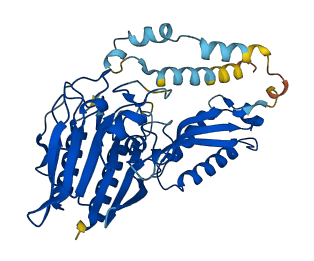O07522
Gene name |
yhaO (BSU09910) |
Protein name |
Uncharacterized metallophosphoesterase YhaO |
Names |
|
Species |
Bacillus subtilis (strain 168) |
KEGG Pathway |
bsu:BSU09910 |
EC number |
|
Protein Class |
|

Descriptions
The autoinhibited protein was predicted that may have potential autoinhibitory elements via cis-regPred.
Autoinhibitory domains (AIDs)
Target domain |
|
Relief mechanism |
|
Assay |
cis-regPred |
Accessory elements
No accessory elements
Autoinhibited structure

Activated structure

1 structures for O07522
| Entry ID | Method | Resolution | Chain | Position | Source |
|---|---|---|---|---|---|
| AF-O07522-F1 | Predicted | AlphaFoldDB |
No variants for O07522
| Variant ID(s) | Position | Change | Description | Diseaes Association | Provenance |
|---|---|---|---|---|---|
| No variants for O07522 | |||||
No associated diseases with O07522
No GO annotations of cellular component
| Name | Definition |
|---|---|
| No GO annotations for cellular component |
3 GO annotations of molecular function
| Name | Definition |
|---|---|
| DNA binding | Any molecular function by which a gene product interacts selectively and non-covalently with DNA (deoxyribonucleic acid). |
| exodeoxyribonuclease activity | Catalysis of the sequential cleavage of mononucleotides from a free 5' or 3' terminus of a DNA molecule. |
| metal ion binding | Binding to a metal ion. |
1 GO annotations of biological process
| Name | Definition |
|---|---|
| DNA repair | The process of restoring DNA after damage. Genomes are subject to damage by chemical and physical agents in the environment (e.g. UV and ionizing radiations, chemical mutagens, fungal and bacterial toxins, etc.) and by free radicals or alkylating agents endogenously generated in metabolism. DNA is also damaged because of errors during its replication. A variety of different DNA repair pathways have been reported that include direct reversal, base excision repair, nucleotide excision repair, photoreactivation, bypass, double-strand break repair pathway, and mismatch repair pathway. |
No homologous proteins in AiPD
| UniProt AC | Gene Name | Protein Name | Species | Evidence Code |
|---|---|---|---|---|
| No homologous proteins | ||||
| 10 | 20 | 30 | 40 | 50 | 60 |
| MLTDLTFIHA | ADLHLDSPFY | GISHLPEPIF | ARIKESTFAS | VRHMIDAAVR | EHVDFILLAG |
| 70 | 80 | 90 | 100 | 110 | 120 |
| DLFDEANRSL | KAQLFLKKQF | ERLRECGISV | YVIFGNHDHL | GGEWTPIEWP | ENVHIFSSAV |
| 130 | 140 | 150 | 160 | 170 | 180 |
| PEEKSFFKEG | RRIASIYGFS | YQARALMENQ | AARYRRSTDA | PFHIGMLHGT | LSGSEGHDPY |
| 190 | 200 | 210 | 220 | 230 | 240 |
| CPFTHDDLVK | SGMDYWALGH | IHKRQVLSAE | HPAVIYPGNT | QARHIKETGD | KGYYLVHVTN |
| 250 | 260 | 270 | 280 | 290 | 300 |
| GDISYEFQRA | HDVLWEKAAV | DVTEAKNMTA | LFQMVEDTFS | KLRKKGSPVC | VRLVLQGTAP |
| 310 | 320 | 330 | 340 | 350 | 360 |
| EWLLEAPKGT | LDEFLEALQE | QEAEEERFVW | PLRLDDETEN | EANLTNLDPF | FGGLFEDIDR |
| 370 | 380 | 390 | 400 | ||
| SDLSDVLEGL | ERHPVYRRHA | DRFSQEEVKE | IKEQAQIILK | RQLKVLDT |